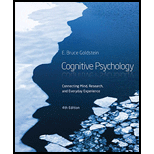
Introduction
The semantic network model allows individuals to form semantic connections between different concepts and categories. It can be considered as a mental database which includes all the things one knows about the world, in an organized manner.
Explanation of Solution
Answer and explanation
As per the Collins and Quillian's model of semantic networks, information about different concepts is stored in the brain in the form of a network that is connected by different nodes where each node represents a concept or a category which further connects with other related concepts.
The initial phase of the semantic network model is based on the theories of Ross Quillian who wanted to create a computer model which mimicked human memory. A simplified version of this model was given by Collins and Quillian in which they explained how the information is stored in a semantic network within the human brain. The model begins at the bottom with a node representing a particular concept such as robin (bird). At this node, one can determine that a robin is red. One can move up the network to derive more general information about robin and find out that it is a bird which can fly, has feathers and wings. At a higher level, one can determine that robin is also an animal which has skin and can move. At last, at the most global level one can see that robin is also a living being which lives and continuously grows. Cognitive economy is an aspect of this model which indicates the existence of a level which has properties that are common to all the related categories.
Meyer and Schvaneveldt opposed the semantic network model by pointing out that this theory failed to explain the typicality effect, wherein, people react more quickly to statements depicting a typical member of a category than they do to the less typical ones. For example, sunfish is a less typical member from the family of fishes and salmon is a typical member from the family of fishes. As per the model, both the members are presented one node away from “fish.” However, according to the typicality effect, people would respond more quickly to salmon than they would to sunfish.
Want to see more full solutions like this?
Chapter 9 Solutions
Cognitive Psychology: Connecting Mind, Research and Everyday Experience (MindTap Course List)
 Ciccarelli: Psychology_5 (5th Edition)PsychologyISBN:9780134477961Author:Saundra K. Ciccarelli, J. Noland WhitePublisher:PEARSON
Ciccarelli: Psychology_5 (5th Edition)PsychologyISBN:9780134477961Author:Saundra K. Ciccarelli, J. Noland WhitePublisher:PEARSON Cognitive PsychologyPsychologyISBN:9781337408271Author:Goldstein, E. Bruce.Publisher:Cengage Learning,
Cognitive PsychologyPsychologyISBN:9781337408271Author:Goldstein, E. Bruce.Publisher:Cengage Learning, Introduction to Psychology: Gateways to Mind and ...PsychologyISBN:9781337565691Author:Dennis Coon, John O. Mitterer, Tanya S. MartiniPublisher:Cengage Learning
Introduction to Psychology: Gateways to Mind and ...PsychologyISBN:9781337565691Author:Dennis Coon, John O. Mitterer, Tanya S. MartiniPublisher:Cengage Learning Psychology in Your Life (Second Edition)PsychologyISBN:9780393265156Author:Sarah Grison, Michael GazzanigaPublisher:W. W. Norton & Company
Psychology in Your Life (Second Edition)PsychologyISBN:9780393265156Author:Sarah Grison, Michael GazzanigaPublisher:W. W. Norton & Company Cognitive Psychology: Connecting Mind, Research a...PsychologyISBN:9781285763880Author:E. Bruce GoldsteinPublisher:Cengage Learning
Cognitive Psychology: Connecting Mind, Research a...PsychologyISBN:9781285763880Author:E. Bruce GoldsteinPublisher:Cengage Learning Theories of Personality (MindTap Course List)PsychologyISBN:9781305652958Author:Duane P. Schultz, Sydney Ellen SchultzPublisher:Cengage Learning
Theories of Personality (MindTap Course List)PsychologyISBN:9781305652958Author:Duane P. Schultz, Sydney Ellen SchultzPublisher:Cengage Learning





